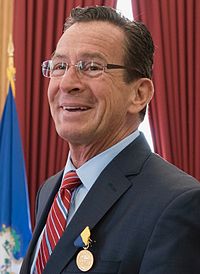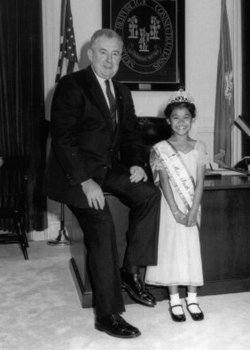List of governors of Connecticut
| Governor of Connecticut | |
|---|---|
 Seal of the Governor | |
since January 5, 2011 | |
| Style | His Excellency |
| Residence | Connecticut Governor's Residence |
| Term length | Four years |
| Inaugural holder | Jonathan Trumbull |
| Deputy | Lieutenant Governor of Connecticut |
| Salary | $150,000 (2013)[1] |
| Website | www.ct.gov/governor |
The Governor of Connecticut is the elected head of the executive branch of Connecticut's state government, and the commander-in-chief of the state's military forces. The governor has a duty to enforce state laws, and the power to either approve or veto bills passed by the Connecticut General Assembly and to convene the legislature.[2] Unusual among U.S. governors, the Governor of Connecticut has no power to pardon.[3] The Governor of Connecticut is automatically a member of the state's Bonding Commission. He is an ex-officio member of the Board of Trustees of the University of Connecticut and Yale University.
There have been 68 post-Revolution governors of the state, serving 72 distinct spans in office. The longest terms in office were in the state's early years, when four governors were elected to nine or more one-year terms. The longest was that of the first governor, Jonathan Trumbull, who served over 14 years, but 7 of those as colonial governor; the longest-serving state governor — with no other position included in the term — was his son, Jonathan Trumbull Jr., who served over 11 years. The shortest term was that of Hiram Bingham III, who served only one day before resigning to take an elected seat in the U.S. Senate. Lowell P. Weicker Jr., is noted for a rare third party win in American politics, having been elected to a term in 1990 representing A Connecticut Party.
The current governor is Dannel Malloy, who took office on January 5, 2011.
List of Governors
- For the period before independence, see the list of colonial governors of Connecticut.
Connecticut was one of the original Thirteen Colonies and was admitted as a state on January 9, 1788.[4] Before it declared its independence, Connecticut was a colony of the Kingdom of Great Britain. Like most early states, Connecticut had claims to western areas, but did not cede all of its claims during the formation of the country like the other states. It maintained its Western Reserve until 1800, at which time it was reassigned to the Northwest Territory.[5]
Connecticut did not create a state constitution for itself until several decades after it became a state; until 1818, the state operated under the provisions of its colonial charter. The charter called for the election of a governor every year, but not more than once every two years, with the term commencing on the second Thursday in May.[6]
The current Constitution of Connecticut, ratified in 1965, calls for a four-year term for the governor,[7] commencing on the Wednesday after the first Monday in the January following an election.[8] The previous constitution of 1818 originally had only a one-year term for governor; this was increased to two years in 1875,[9] and four years in 1948.[10] The 1875 amendment also set the start date of the term to its current date; before then, it was the first Wednesday in the May following an election.[11] The constitution provides for the election of a lieutenant governor for the same term as the governor. The two offices are elected on the same ticket; this provision was added in 1962.[12] In the event of a vacancy in the office of governor, the lieutenant governor becomes governor.[13] Before the adoption of the 1965 constitution, the lieutenant governor only acted as governor.[14] There is no limit of any kind on the number of terms one may serve.
Notes
- ^ According to the Connecticut State Library, the official listing goes back to the first governor of Connecticut Colony in 1639, and did not include repeat governors serving non-consecutive terms in the colonial period; this makes Trumbull the 16th governor.[15] The official numbering since statehood includes repeat and acting governors.
- ^ The office of Lieutenant Governor was known as Deputy-Governor under the colonial charter, but the name 'Lieutenant Governor' was predominantly used after independence.[6]
- ^ Lieutenant governors represented the same party as their governor unless noted.
- ^ The Connecticut General Assembly approved the United States Declaration of Independence on October 10, 1776, and resolved that the state's government would continue as established under the charter. So, as colonial governor, Jonathan Trumbull became state governor, serving roughly 14 years total.[16]
- ^ Huntington died in office; as lieutenant governor, Wolcott acted as governor for the remainder of the term.
- ^ Trumbull died in office; as lieutenant governor, Treadwell acted as governor for the remainder of the term.
- ^ Appointed by the general assembly to fill the vacant Lieutenant Governor office.[18]
- ^ Griswold died in office; as lieutenant governor, Smith acted as governor for the remainder of the term.
- ^ Represented the Democratic-Republican Party.
- ^ a b Represented the National Republican Party.
- ^ Tomlinson resigned to take an elected seat in the United States Senate; as lieutenant governor, Peters acted as governor for the remainder of the term.
- ^ Toucey lost the election, but was appointed governor by the state legislature.[19]
- ^ James English won the popular vote, but a canvassing committee found the election was fraudulent, and named Jewell governor several days into the term.[21]
- ^ The end date of this term was moved back to January 3, 1877, due to the adoption of the 26th amendment to the state constitution, lengthening the term by 7 months.
- ^ Terms were lengthened from one to two years beginning with this term.
- ^ Morgan Bulkeley did not run for re-election in 1890, but due to such a close contest and controversies, the results were not certified, and the legislature spent two years debating the issue; Bulkeley essentially served as governor by default.[22]
- ^ Lilley died in office; as lieutenant governor, Weeks acted as governor for the remainder of the term.
- ^ a b c Represented the Republican Party.
- ^ Bingham resigned to take an elected seat in the United States Senate; as lieutenant governor, Trumbull acted as governor for the remainder of the term.
- ^ a b c As president pro tempore of the state senate, filled vacancy in office of lieutenant governor.[18]
- ^ Baldwin resigned to take an elected seat in the United States Senate; as lieutenant governor, Snow acted as governor for the remainder of the term.
- ^ a b Represented the Democratic Party.
- ^ McConaughy died in office; as lieutenant governor, Shannon acted as governor for the remainder of the term.
- ^ Terms were lengthened from two to four years beginning with this term.
- ^ Ribicoff resigned to become U.S. Secretary of Health, Education, and Welfare; as lieutenant governor, Dempsey acted as governor for the remainder of the term.
- ^ a b c d As president pro tempore of the state senate, became lieutenant governor.[18]
- ^ Grasso resigned due to ovarian cancer; as lieutenant governor, O'Neill succeeded her.
- ^ Rowland resigned due to a federal corruption investigation;[23] he later pleaded guilty to corruption.[24] as lieutenant governor, Rell succeeded him.
- ^ Governor Malloy's second term expires on January 9, 2019.
References
- General
- "Governors of Connecticut". National Governors Association. Archived from the original on September 11, 2016. Retrieved August 29, 2016.
{{cite web}}: Unknown parameter|dead-url=ignored (|url-status=suggested) (help) - "Governors of Connecticut". Connecticut State Library. Retrieved February 24, 2009.
- Loomis, Dwight; Joseph Gilbert Calhoun (1895). The Judicial and Civil History of Connecticut. The Boston History Company. pp. 114–117. Retrieved August 4, 2010.
- Constitutions
- "Constitution of the State of Connecticut". Connecticut State Library. 1965. Archived from the original on March 23, 2009. Retrieved February 21, 2009.
{{cite web}}: Unknown parameter|deadurl=ignored (|url-status=suggested) (help) - "Constitution of the State of Connecticut". Secretary of the State of Connecticut. 1818. Archived from the original on 2009-04-22. Retrieved February 21, 2009.
{{cite web}}: Unknown parameter|dead-url=ignored (|url-status=suggested) (help) - "Charter of the Colony of Connecticut". National Humanities Institute. 1662. Retrieved February 21, 2009.
- Specific
- ^ "CSG Releases 2013 Governor Salaries". The Council of State Governments. June 25, 2013. Retrieved November 23, 2014.
- ^ CT Const. art. IV
- ^ "Pardons Power in Connecticut". Archived from the original on June 13, 2008. Retrieved June 13, 2008.
- ^ "Today in History: January 9". Library of Congress. Retrieved February 21, 2009.
- ^ "Research Guide to Connecticut's "Western Lands" or "Western Reserve"". Connecticut State Library. Archived from the original on December 26, 2008. Retrieved February 21, 2009.
{{cite web}}: Unknown parameter|deadurl=ignored (|url-status=suggested) (help) - ^ a b 1662 Charter
- ^ CT Const. art. IV, § 1
- ^ CT Const. art. IV, § 2
- ^ 1818 Const. amendment XVI
- ^ 1818 Const. amendment XLV
- ^ 1818 Const. art. IV § 1
- ^ 1818 Const. new amendment VII
- ^ CT Const. art. IV § 19
- ^ 1818 Const. art. IV § 14
- ^ "Roster of Connecticut Governors". Connecticut State Library. Retrieved April 4, 2008.
- ^ "Jonathan Trumbull". Connecticut State Library. Archived from the original on 2008-12-26. Retrieved 2009-03-10.
{{cite web}}: Unknown parameter|deadurl=ignored (|url-status=suggested) (help) - ^ Wolcott died in office; as lieutenant governor, Trumbull acted as governor for the remainder of the term.
- ^ a b c "Brief Descriptions of Connecticut State Agencies: Lieutenant Governor". Connecticut State Library. Archived from the original on 2007-10-26. Retrieved 2009-03-10.
{{cite web}}: Unknown parameter|deadurl=ignored (|url-status=suggested) (help) - ^ "Toucey, Issac". Biographical Directory of the United States Congress. Clerk of the United States House of Representatives and Historian of the United States Senate. Retrieved February 22, 2009.
- ^ Seymour resigned to be U.S. Minister to Russia; as lieutenant governor, Pond acted as governor for the remainder of the term.
- ^ "James Edward English". National Governors Association. Archived from the original on September 11, 2016. Retrieved August 29, 2016.
{{cite web}}: Unknown parameter|dead-url=ignored (|url-status=suggested) (help) - ^ "Morgan Gardner Bulkeley". National Governors Association. Retrieved August 29, 2016.
- ^ "Connecticut's Governor Steps Down". The New York Times. June 22, 2004.
{{cite news}}: Unknown parameter|authors=ignored (help) - ^ Robert D. McFadden (December 24, 2004). "An Ex-Governor Says He's Guilty". The New York Times.
External links
































































